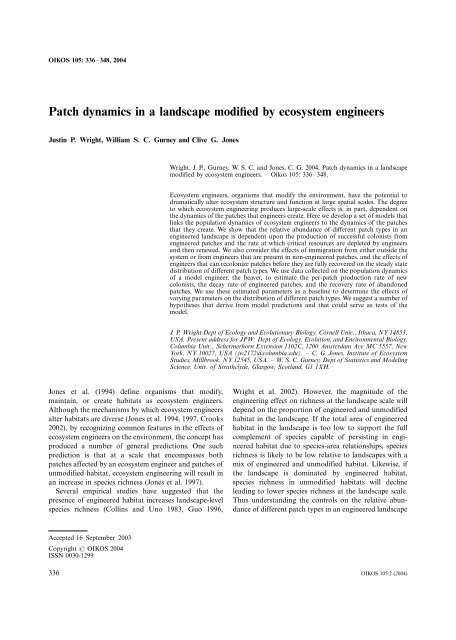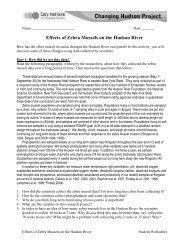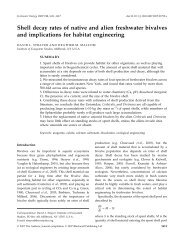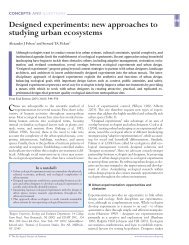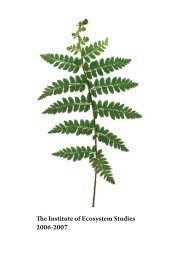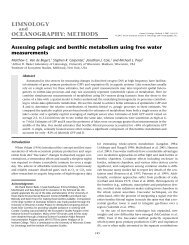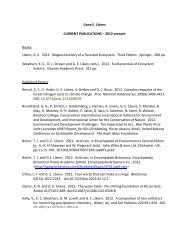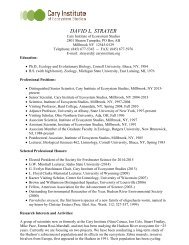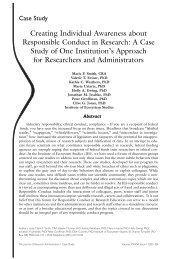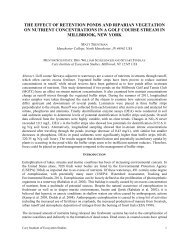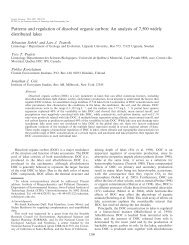Patch dynamics in a landscape modified by ecosystem engineers
Patch dynamics in a landscape modified by ecosystem engineers
Patch dynamics in a landscape modified by ecosystem engineers
You also want an ePaper? Increase the reach of your titles
YUMPU automatically turns print PDFs into web optimized ePapers that Google loves.
is critical for predict<strong>in</strong>g the effect of eng<strong>in</strong>eers on speciesrichness at the <strong>landscape</strong> scale.Gurney and Lawton (1996) developed a model of thepopulation <strong>dynamics</strong> of <strong>ecosystem</strong> eng<strong>in</strong>eers that l<strong>in</strong>kedthe production and decay of eng<strong>in</strong>eered habitats to thepopulation <strong>dynamics</strong> of eng<strong>in</strong>eers. Specifically, themodel focused on allogenic eng<strong>in</strong>eers that must modifytheir habitat to survive, (e.g. beaver damm<strong>in</strong>g streamsand pocket gophers digg<strong>in</strong>g burrows) as opposed tothose where the eng<strong>in</strong>eer<strong>in</strong>g activity has no effect on theeng<strong>in</strong>eers performance (e.g. hippopotamus form<strong>in</strong>g trailsand buffalo creat<strong>in</strong>g wallows). Allogenic eng<strong>in</strong>eers arethose eng<strong>in</strong>eers that modify the environment <strong>by</strong> transform<strong>in</strong>gliv<strong>in</strong>g or non-liv<strong>in</strong>g materials from one physicalstate to another primarily <strong>by</strong> mechanical means (Jones etal. 1994), and as a result create patches that can persisteven if the organism that created them is no longerpresent. Gurney and Lawton (1996) focused primarily onthe conditions for stability of populations of eng<strong>in</strong>eers.However, their model also predicted steady state valuesfor the proportion of eng<strong>in</strong>eered and un<strong>modified</strong>habitats.Here, we modify Gurney and Lawton’s orig<strong>in</strong>al (1996)model and analyze how the model’s parameters affectthe steady state abundance of different habitat types. Wealso use data collected on the population <strong>dynamics</strong> of aparticularly well-studied <strong>ecosystem</strong> eng<strong>in</strong>eer, the beaver,to estimate values for several of the model’s parameters.Us<strong>in</strong>g these estimated parameter values, we explore theeffects of vary<strong>in</strong>g parameters on the relative abundanceof different habitat types.ModelsSimple patch dynamic modelIn the simplest version of the model, patches with<strong>in</strong> a<strong>landscape</strong> can be found <strong>in</strong> one of three potential states:potential, active, and degraded. <strong>Patch</strong>es <strong>in</strong> the potentialstate are transformed <strong>in</strong>to active patches via the processof colonization of the patch <strong>by</strong> dispers<strong>in</strong>g <strong>ecosystem</strong>eng<strong>in</strong>eers arriv<strong>in</strong>g from active patches. <strong>Patch</strong>es aretransformed from the active state to the degraded statewhen the patch is abandoned, and patches change fromdegraded to potential through a process of recovery (Fig.1A, Table 1). If we denote the proportion of patches <strong>in</strong>the potential, active, and degraded states at time t <strong>by</strong> P,A, and D respectively, then we know that1PAD (1)We assume that a unit of active habitat has a constantprobability per unit time of decay<strong>in</strong>g <strong>in</strong>to the degradedstate (d) and that a unit of degraded habitat has aconstant probability per unit time of recover<strong>in</strong>g to thepotential state (r). We further assume that each activepatch generates a constant number of <strong>in</strong>dividuals perFig. 1. A) Structure of the simple (3-patch) model and B)complex (4-patch) model of the <strong>dynamics</strong> of patches <strong>in</strong> aneng<strong>in</strong>eered system. <strong>Patch</strong>es that are actively occupied <strong>by</strong>eng<strong>in</strong>eers are designated A, and decay <strong>in</strong>to degraded patches(D) follow<strong>in</strong>g abandonment. Degraded patches recover <strong>in</strong>topotentially habitable patches (P) which are then recolonized toform active patches. In the 4-patch model, if potential patchesare not recolonized, they progress to the fully recovered (F)state.Table 1. Description of the parameters <strong>in</strong> simple (3-patch) andcomplex (4-patch) models of the <strong>dynamics</strong> of patches <strong>in</strong> aneng<strong>in</strong>eered system.Parameter Descriptionndrirzunit time that succeed <strong>in</strong> convert<strong>in</strong>g a potential patch<strong>in</strong>to an active patch (n). Recall<strong>in</strong>g that Eq. 1 allows us tocalculate P t given A t and D t , we can describe the<strong>dynamics</strong> of this system <strong>by</strong> two differential equations:dAdt nA(1AD)dAdDdt dArD(2a)(2b)This system has two biologically relevant steady states.One, which we call the zero-eng<strong>in</strong>eer state has A* (theproportion of the <strong>landscape</strong> <strong>in</strong> the active state atequilibrium)/D*/0 and P*/1. The other, which wecall the f<strong>in</strong>ite eng<strong>in</strong>eer state, hasA 1 d=n1 d=rPer-patch production rate of new colonistsDecay rate of patches from active (A) to degraded(D) stateRecovery rate of patches from degraded (D) topotential (P) stateImmigration rateRecovery rate of patches from potential (P) state tofully recovered (F) stateDiscrim<strong>in</strong>ation of colonists aga<strong>in</strong>st potential (P)relative to fully recovered (F) patchesD dA rFor this steady state to be biologically mean<strong>in</strong>gful, itmust have A*/0 and D*/0, which <strong>in</strong> turn requiresn/d/0. This implies that for the eng<strong>in</strong>eer to persist,the number of new patches created per unit time mustexceed the patch degradation rate.(3)OIKOS 105:2 (2004) 337
Simple patch dynamic model with immigrationIn the <strong>in</strong>itial formulation of the model, the rate oftransformation of all P patches to A patches is dependenton the abundance of A patches <strong>in</strong> the <strong>landscape</strong>.This is the case when dispers<strong>in</strong>g eng<strong>in</strong>eers can only arisefrom eng<strong>in</strong>eered patches with<strong>in</strong> the system. However, itis conceivable that there are patches <strong>in</strong> the <strong>landscape</strong> thatcan support eng<strong>in</strong>eers without habitat modification andthus persist <strong>in</strong>def<strong>in</strong>itely. For example, beaver live primarily<strong>in</strong> ponds that they create <strong>by</strong> damm<strong>in</strong>g streams(convert<strong>in</strong>g a patch from P to A). These active coloniesproduce new colonists that disperse and create newactive patches. However, beaver can also live <strong>in</strong> naturallakes and ponds, produc<strong>in</strong>g a source of colonists that is<strong>in</strong>dependent of the number of beaver-created ponds <strong>in</strong>the <strong>landscape</strong>. To address a situation where there is asource of colonists <strong>in</strong>dependent of the stock of eng<strong>in</strong>eeredpatches, we modify the orig<strong>in</strong>al model to <strong>in</strong>cludean additional constant <strong>in</strong>flow of immigrants at rate i,thus yield<strong>in</strong>g:dAdt (nAi)(1AD)dA(4a)dDdt dArD(4b)This system has only one biologically mean<strong>in</strong>gful steadystate, at which A* is a solution of(n[1d=r])A 2 (i[1d=r]dn)A10 (5)If all parameters (<strong>in</strong>clud<strong>in</strong>g i) are assumed to takepositive values, this equation must have exactly onef<strong>in</strong>ite positive solution. Thus, when immigration is addedto the model, the system always has a s<strong>in</strong>gle f<strong>in</strong>iteeng<strong>in</strong>eersteady state but no longer has a zero-eng<strong>in</strong>eersteady state.Partial patch recoveryWe now recognize an additional patch state to reflect anadditional stage of recovery from the effects of <strong>ecosystem</strong>eng<strong>in</strong>eer<strong>in</strong>g (Fig. 1B). This can occur when <strong>ecosystem</strong>eng<strong>in</strong>eers create patches where recovery rates of thenecessary resource are not equal throughout the patch.For example, beaver can recolonize a meadow site thathas undergone sufficient forest regeneration around theedge of the former pond prior to any woody regenerationwith<strong>in</strong> the former pond site itself. In this system,patches <strong>in</strong> the P state represent a recolonisable but notfully recovered state, and patches can additionally exist<strong>in</strong> the fully recovered state. Hence, if we denote theproportion of fully recovered patches <strong>in</strong> the <strong>landscape</strong> <strong>by</strong>F, then1FADP (6)We aga<strong>in</strong> assume that a unit of active habitat has aconstant probability per unit time of decay<strong>in</strong>g <strong>in</strong>to thedegraded state (d), that a unit of degraded habitat has aconstant probability per unit time of recover<strong>in</strong>g to thepotential state (r), and that each active patch generates aconstant number of <strong>in</strong>dividuals per unit time thatsucceed <strong>in</strong> convert<strong>in</strong>g a potential patch <strong>in</strong>to an activepatch (n). The rate at which A is generated is no longerstrictly dependent on P, but on the sum of (F/zP) wherez represent the degree of discrim<strong>in</strong>ation aga<strong>in</strong>st previously<strong>modified</strong> patches. At this po<strong>in</strong>t we assume thatproduction of colonists from active patches is <strong>in</strong>dependentof patch history. We also assume that patches <strong>in</strong> theP state recover at a constant rate per unit time to the Fstate (r). Remember<strong>in</strong>g Eq. 6 allows us to calculate anygiven state variable if we know the other three, so we canrepresent the <strong>dynamics</strong> of our extended system <strong>by</strong>:dAdt nA(Fz)dA(7a)dDdt dArD(7b)dPdt rDrPnAzP(7c)The system has two steady states / the zero eng<strong>in</strong>eerstate where A*/D*/P*/0 and F*/1, and a f<strong>in</strong>iteeng<strong>in</strong>eersteady state, at which A* is the solution of(nz[1d=r])A 2 (r[1d=r]d[1z]nz[1d=n])Ar(1d=n)0 (8)Thus, as long as the patch specific colonization rate isgreater than the degredation rate (n/d) there must be atleast one non-zero positive (real) solution for A*.Beaver as a model systemBeaver are a particularly well-studied example of <strong>ecosystem</strong>eng<strong>in</strong>eers. Beaver have been documented to affectriparian trees (Barnes and Dibble 1986, Nummi 1989,Johnston and Naiman 1990b), biogeochemistry ofstreamwater (Naiman et al. 1986, Margolis et al. 2001)and soil (Johnston et al. 1995), fish populations (Hansonand Campbell 1963, Snodgrass and Meffe 1998), diversityof aquatic <strong>in</strong>vertebrates (McDowell and Naiman1986), birds (Grover and Baldassarre 1995, Nummi andPoysa 1997), and herbaceous plants (Wright et al. 2002),and succession (McMaster and McMaster 2000). Allriparian effects of beaver are the result of their <strong>ecosystem</strong>eng<strong>in</strong>eer<strong>in</strong>g activities, with the possible exception ofchanges <strong>in</strong> the composition of riparian trees, due <strong>in</strong> partto herbivory. Specifically, these effects are caused <strong>by</strong> abeaver dam transform<strong>in</strong>g a free-runn<strong>in</strong>g stream <strong>in</strong>to apond that floods the adjacent riparian zone, or <strong>by</strong> the338 OIKOS 105:2 (2004)
dra<strong>in</strong><strong>in</strong>g of a pond and exposure of accumulatedsediments follow<strong>in</strong>g abandonment of a site and subsequentdam failure.In the model, beaver ponds with a resident colony areconsidered as active patches (A). Typically, only theoldest pair of beaver <strong>in</strong> a colony will reproduce,produc<strong>in</strong>g on average 3 or 4 young annually (Jenk<strong>in</strong>sand Busher 1979). Colonies typically consist of an adultpair, yearl<strong>in</strong>gs, and kits, with an average size of 5.859/0.61 (SE) <strong>in</strong>dividuals (Svendsen 1980). Young beaverdisperse at about 2 or 3 years of age (Jenk<strong>in</strong>s and Busher1979, Svendsen 1980), although if food supplies areplentiful or local population densities are high, as manyas 50% of two-year old beaver can rema<strong>in</strong> at their natalcolony (van Deelen and Pletscher 1996). Dispersaldistances tend to be less than 16 km (Beer 1955, Leege1968), but distances of up to 110 km have been reported(Hibbard 1958). Mortality dur<strong>in</strong>g dispersal tends to behigh relative to non-dispers<strong>in</strong>g beaver, with mortalityrates of 40% be<strong>in</strong>g reported for the 1.5/2.5 year class ofbeaver <strong>in</strong> Newfoundland (Payne 1984). Birth rates percolony, site fidelity and mortality dur<strong>in</strong>g dispersal areimportant factors <strong>in</strong> determ<strong>in</strong><strong>in</strong>g the model parameter n,or the per patch production rate of successful colonists.Although these factors are likely to vary across the rangeof beaver, if one assumes the figures reported above arestandard for beaver across their range, one can estimatea value for n of 0.7 successful immigrants per year.It is also possible that the creation of active patchesmay be affected <strong>by</strong> the presence of colonies of beaverthat occur <strong>in</strong> sites that do not require habitat modification.Beaver are known to build lodges on naturallyoccurr<strong>in</strong>g lakes and ponds as well as <strong>in</strong> the banks oflarger rivers without perform<strong>in</strong>g any significant eng<strong>in</strong>eer<strong>in</strong>g.In <strong>landscape</strong>s where such patches are present,the number of successful colonists that are produced <strong>by</strong>these non-eng<strong>in</strong>eered sites (i) will <strong>in</strong>fluence the rate atwhich new active patches are formed. Although it ispossible that the number of colonists com<strong>in</strong>g from noneng<strong>in</strong>eeredpatches is not constant and might depend onthe number of eng<strong>in</strong>eered patches <strong>in</strong> a <strong>landscape</strong>, tosimplify analysis of the model, we have assumed aconstant rate of immigration.Over time, active colonies deplete the food resourcesadjacent to the pond, ponds fill with sediment, andresident beaver die eventually lead<strong>in</strong>g to abandonment.The rate at which this occurs (d) will be a function ofcolony size, beaver activity, the composition and abundanceof riparian zone trees or other food resources, andsediment loads of dammed streams. Knudson (1962)reported that beaver ponds may rema<strong>in</strong> active for as longas 8/10 years, while <strong>in</strong> Algonqu<strong>in</strong> Prov<strong>in</strong>cial Park,Canada, sites were occupied for an average of 5.89/0.46 (SE) years over a ten year period (Fryxell 2001).Once ponds are abandoned, they develop <strong>in</strong>to wetlandswith variable hydrologic regimes and vegetation composition(Remillard et al. 1987, Johnston and Naiman1990c, McMaster and McMaster 2000, Wright et al.2002). The sites rema<strong>in</strong> <strong>in</strong> this state (equivalent todegraded, D, patches) until the vegetation <strong>in</strong> the areaadjacent to the former pond site has recovered to adegree sufficient to support a new beaver colony. Therate at which this transformation from D patches to Ppatches occurs (r) depends on the successional <strong>dynamics</strong>of the forests surround<strong>in</strong>g pond sites.In most areas, once beaver have colonized a site, thesite enters <strong>in</strong>to a pattern of cyclic abandonment andrecolonization. It is relatively rare for a site that has beencolonized <strong>by</strong> beaver to revert back to a forested riparianzone (equivalent to the F state <strong>in</strong> the more complexpatch dynamic model, Ives 1942, Remillard et al. 1987,Johnston and Naiman 1990a, Pastor et al. 1993,Terwilliger and Pastor 1999), thus the parameter r islikely to be extremely low <strong>in</strong> most <strong>ecosystem</strong>s affected <strong>by</strong>beaver. The degree to which beaver prefer or avoid sitesthat have been previously colonized relative to forestedriparian zone (z) will aga<strong>in</strong> depend on the successional<strong>dynamics</strong> of the riparian zone vegetation. In many areas,recently abandoned sites are dom<strong>in</strong>ated <strong>by</strong> species ofSalix, Populus and Alnus, preferred food species ofbeaver (Jenk<strong>in</strong>s and Busher 1979). The situation whereherbivores, such as beaver, create environments favorablefor the growth of early-successional species, which areoften preferred <strong>by</strong> beaver, has been termed the retardedsuccession hypothesis (Pastor and Naiman 1992). However,it is also possible for beaver forag<strong>in</strong>g to facilitate thedom<strong>in</strong>ance of conifers and other late-successional speciesthat are typically avoided as food sources, (theaccelerated succession hypothesis, Fryxell 2001).Furthermore, it has been shown that brows<strong>in</strong>g <strong>by</strong> beavercan <strong>in</strong>crease rates of phenolic glycoside production <strong>in</strong>Populus fremontii (Mart<strong>in</strong>sen et al. 1998). If suchchemical defenses aga<strong>in</strong>st mammalian herbivory persistor brows<strong>in</strong>g <strong>by</strong> beaver leads to dom<strong>in</strong>ance of nonpreferredspecies, sites that have been previously occupied<strong>by</strong> beaver might be avoided.Beaver activity on the Hunt<strong>in</strong>gton Wildlife Forest(HWF) has been surveyed annually s<strong>in</strong>ce 1979. TheHWF is a 6000-hectare preserve located <strong>in</strong> the centralAdirondack Mounta<strong>in</strong>s, NY (latitude 44800?N, longitude74813?W). The topography is mounta<strong>in</strong>ous withelevations rang<strong>in</strong>g from 457 m to 823 m. Vegetationconsists of mixed northern hardwood and coniferousforest. As part of the Adirondack Long Term Monitor<strong>in</strong>gProject (ALTEMP), all active beaver sites on HWFhave been identified and mapped every fall s<strong>in</strong>ce 1979.Although the number of colonies has fluctuated overtime (Fig. 2), the number of beaver colonies hasrema<strong>in</strong>ed relatively constant, particularly s<strong>in</strong>ce 1990.Although there is some variability <strong>in</strong> the numbers of<strong>in</strong>dividuals per colony, colony counts can provide auseful estimate of population sizes for beaver (BergerudOIKOS 105:2 (2004) 339
Fig. 2. Number of active beaver colonies on the Hunt<strong>in</strong>gtonWildlife Forest (HWF) recorded dur<strong>in</strong>g annual censuses fromthe period 1979/1998.and Miller 1977). Assum<strong>in</strong>g that beaver populations areclose to steady state <strong>in</strong> the central Adirondacks, datafrom these surveys can be used to estimate several of theparameters of the model.We estimated d, the rate of decay from A (active) to D(degraded) patches, <strong>by</strong> calculat<strong>in</strong>g the mean period oftime that ponds rema<strong>in</strong>ed active, consider<strong>in</strong>g only pondsthat were colonized after 1979 and abandoned prior to1999. If one assumes that d is distributed exponentially,then the rate of decay is the <strong>in</strong>verse of the mean age ofthe patch. For the period from 1979/1999, the meantime of occupation for beaver ponds on HWF was 4.8years9/0.34 (SE) yield<strong>in</strong>g an estimate of d/0.21.The production rate of successful colonists per patch(n) is slightly more difficult to estimate. S<strong>in</strong>ce beavercolonies occur on natural lakes <strong>in</strong> HWF, dispersal of<strong>in</strong>dividuals from patches not created <strong>by</strong> beaver almostcerta<strong>in</strong>ly occurs. However, divid<strong>in</strong>g the number of newlyactive sites <strong>in</strong> a year <strong>by</strong> the number of active colonies <strong>in</strong>the previous year produces an upper bound for theestimate of n (essentially ignor<strong>in</strong>g the effects of noneng<strong>in</strong>eer<strong>in</strong>gcolonies). For the period from 1980/1999,this technique yields an average estimate of n/0.399/0.03, lower than the value of 0.7 predicted from theliterature.The data from the annual beaver census are <strong>in</strong>sufficientfor estimat<strong>in</strong>g the other parameters of the simplepatch dynamic model. Estimat<strong>in</strong>g the rate of recoveryfrom degraded (D) to potential (P) patches, r, requiresmeasur<strong>in</strong>g recovery <strong>in</strong> the forests adjacent to pond sitesas well as determ<strong>in</strong><strong>in</strong>g the m<strong>in</strong>imum requirements forcolonization <strong>by</strong> beaver. However, the mean time periodthat ponds were abandoned was 4.799/0.35 years,suggest<strong>in</strong>g a m<strong>in</strong>imum value of r/0.21. Estimat<strong>in</strong>gimmigration from non-eng<strong>in</strong>eer<strong>in</strong>g patches (i) wouldrequire track<strong>in</strong>g dispers<strong>in</strong>g <strong>in</strong>dividuals from suchpatches and determ<strong>in</strong><strong>in</strong>g successful colonization rates.Estimat<strong>in</strong>g the additional parameters of the morecomplex patch model is also somewhat challeng<strong>in</strong>g.The rate of recovery from previously used sites toforested riparian zone is difficult to estimate, but canbe safely assumed to be extremely low given the raritywith which such transitions have been observed (Remillardet al. 1987, Pastor et al. 1993). We can estimatebeaver relative preference for virg<strong>in</strong> or fully recoveredversus previously <strong>modified</strong> patches (z) us<strong>in</strong>g data fromthe annual beaver surveys. The ratio of the proportion ofpreviously used available patches that are colonized tothe proportion of virg<strong>in</strong> habitat colonized <strong>in</strong> a given yearis an <strong>in</strong>dex of habitat preference. Values greater than 1<strong>in</strong>dicate a preference for previously used habitat whilevalues less than 1 <strong>in</strong>dicate preference for virg<strong>in</strong> habitat.If one assumes that all possible patches on HWF havebeen colonized <strong>by</strong> the latest year of the beaver survey(1999), one can calculate a lower limit for z. Ignor<strong>in</strong>gyears <strong>in</strong> which no beaver colonized previously virg<strong>in</strong>habitat, the mean value of z between 1981 and 1998 is1.21, <strong>in</strong>dicat<strong>in</strong>g a slight preference <strong>by</strong> beaver forpreviously eng<strong>in</strong>eered habitat. There is a significanttrend for this estimate of z to decrease over time(F 1,12 /21.32, r 2 /0.66, p/0.0007, Fig. 3), with preferencefor previously <strong>modified</strong> habitats switch<strong>in</strong>g topreference for virg<strong>in</strong> habitat around 1986.We solved the system of differential equations todeterm<strong>in</strong>e the steady state values of the proportions ofthe different habitat types while vary<strong>in</strong>g one parameterand hold<strong>in</strong>g all other parameters <strong>in</strong> the model constant.In solutions <strong>in</strong> which they were held constant we usedthe values of d (0.21), n (0.39), and z (1.21) estimatedfrom annual beaver surveys. We held r constant at 0.25(yield<strong>in</strong>g a mean recovery time from degraded <strong>in</strong>topotential patches of 4 years), r at 0.01 (yield<strong>in</strong>g a meanrecovery time from potential <strong>in</strong>to fully recovered patchesof 100 years), and i at 0.1.Fig. 3. Log of preference <strong>in</strong>dex for fully recovered (F) versuspreviously <strong>modified</strong> sites (P) for use as sites for colonizationderived from HWF beaver censuses between 1980 and 1998.Untransformed values greater than one <strong>in</strong>dicate a preference forpreviously occupied habitat. The equation for the best fitregression is log (y)/167.44/0.08x.340 OIKOS 105:2 (2004)
ResultsSimple modelAs d, the decay rate of patches from the active todegraded state, <strong>in</strong>creases, the proportion of the <strong>landscape</strong><strong>in</strong> the P* (potential) state <strong>in</strong>creases <strong>in</strong> a near l<strong>in</strong>earfashion until d/n, the per-patch production rate of newcolonists, at which po<strong>in</strong>t P* reaches a maximum at 1(Fig. 4A). At low values of d, most of the <strong>landscape</strong> is <strong>in</strong>the A (active) state, but the proportion of A* decreasessteadily as d <strong>in</strong>creases, reach<strong>in</strong>g 0 when d/n. Theproportion of D* (degraded) patches <strong>in</strong> the <strong>landscape</strong>shows a unimodal relationship as d <strong>in</strong>creases, represent<strong>in</strong>ga trade-off between low production of degradedpatches at low d, and a low supply of active patches athigh d.Vary<strong>in</strong>g r, the recovery rate of degraded patches <strong>in</strong>topotential patches, while keep<strong>in</strong>g the values of the otherparameters constant has no effect on the steady statevalue of P* (Fig. 4B), as potential patches are rapidlytransformed to active patches. As r <strong>in</strong>creases, D*decreases and A* <strong>in</strong>creases, with dom<strong>in</strong>ance betweenthe two patch types switch<strong>in</strong>g when r/d, represent<strong>in</strong>gthe po<strong>in</strong>t at which old patches decay more rapidly thannew patches are created.At levels of nB/d, the <strong>landscape</strong> is at the zero-eng<strong>in</strong>eersteady state with P*/1, and A*/D*/0 (Fig. 4C). Asn <strong>in</strong>creases above this po<strong>in</strong>t, P* decreases steadily whileA* and D* <strong>in</strong>crease. If dB/r, A* will <strong>in</strong>crease morerapidly than D* and reach a higher value as n <strong>in</strong>creaseswhile if d/r, D* will <strong>in</strong>crease more rapidly.Simple model with immigrationAdd<strong>in</strong>g immigration changes the <strong>dynamics</strong> of the systemquite considerably. Fig. 5A illustrates that <strong>in</strong>creas<strong>in</strong>g daga<strong>in</strong> causes A* to decrease steadily although, withimmigration, a value of 0 is no longer possible. The moststrik<strong>in</strong>g difference is that even with small amounts ofimmigration, P* <strong>in</strong>creases much more slowly with d andat a rate that is far from l<strong>in</strong>ear (compared to Fig. 4A).Also, D* only decreases slightly at high values of d ratherthan peak<strong>in</strong>g at low values of d and then decreas<strong>in</strong>g.With immigration, P* is no longer <strong>in</strong>dependent of r,but decreases to values near 0 at low values of r (Fig.5B). However, add<strong>in</strong>g immigration does not affect thebasic relationship between r and A* or D*. At lowvalues of n, immigration prevents the system frombecom<strong>in</strong>g fixed at P*/1 and A*/D*/0 (Fig. 5C).Apart from that, the relationship between the steadystate values of the state variables and different values ofn are similar with and without immigration (Fig. 4C,5C), although the responses are dampened with immigration.Fig. 4. Dynamics of steady state values for state variables of thesimple (3-patch) model without immigration <strong>in</strong> response tochanges <strong>in</strong> the model parameters. In simulations where theywere held constant, d/0.21 (A), r/0.25 (B), and n/0.39 (C).Although add<strong>in</strong>g immigration to the model alters therelationships between the other parameters and the statevariables, vary<strong>in</strong>g the immigration rate itself has arelatively small effect on A* and D* (Fig. 5D). At verylow levels of i, P* <strong>in</strong>creases while A* and D* decrease.Figure 6A shows that at low values of d, add<strong>in</strong>gimmigration has little effect on the steady state values ofOIKOS 105:2 (2004) 341
Fig. 6. Difference between the steady state values for statevariables with (i/0.1) and without immigration. In simulationswhere they were held constant, d/0.21 (A), r/0.25 (B), andn/0.39 (C).Fig. 5. Dynamics of steady state values for state variables of thesimple (3-patch) model with immigration <strong>in</strong> response to changes<strong>in</strong> the model parameters. In simulations where they were heldconstant, d/0.21 (A), r/0.25 (B), n/0.39 (C), and i/0.1(D).any of the state variables. At high values of d, the majoreffect of add<strong>in</strong>g immigration is to <strong>in</strong>crease the proportionof D* while decreas<strong>in</strong>g the proportion of P*.Immigration causes the relative abundance of A* andD* to <strong>in</strong>crease and P* to decrease until d/n. At valuesof d/n, the differences between the values of the statevariables with and without immigration beg<strong>in</strong> to decrease.Add<strong>in</strong>g immigration only causes small changes <strong>in</strong>the effect of r, on the steady state values of the state342 OIKOS 105:2 (2004)
variables, and this effect is largest at low values of r (Fig.6B). Add<strong>in</strong>g immigration also affects the relationshipbetween n and the steady state values of the statevariables at low values of the parameter, but themagnitude of the effect is much larger (Fig. 6C). Thedifferences between the steady state values of the statevariables <strong>in</strong> the model with and without immigrationbeg<strong>in</strong> to decrease at n/d. For all values of all threeparameters, the effect of add<strong>in</strong>g immigration (at i/0.1)is to reduce the proportion of P* while <strong>in</strong>creas<strong>in</strong>g theproportion of A* and D*.Partial recovery modelAdd<strong>in</strong>g a fourth patch type to the model causes severalimportant changes to the behavior of the model.Increas<strong>in</strong>g d causes A* to decrease steadily and F* to<strong>in</strong>crease steadily while D* and P* reach a maximum at<strong>in</strong>termediate values of d (Fig. 7A). Not surpris<strong>in</strong>gly,<strong>in</strong>creas<strong>in</strong>g r causes D* to decrease (Fig. 7B). Interest<strong>in</strong>gly,vary<strong>in</strong>g r only results <strong>in</strong> a slight <strong>in</strong>crease <strong>in</strong> P*except at low values of r presumably because patches <strong>in</strong>the P state are quickly transformed <strong>in</strong>to A account<strong>in</strong>gfor the <strong>in</strong>crease <strong>in</strong> A* as r <strong>in</strong>creases. Increas<strong>in</strong>g r has anegative effect on F*, particularly at low values of r. Atvalues of n/d, F* and P* steadily decrease as n<strong>in</strong>creases while A* and D* <strong>in</strong>crease (Fig. 7C). Increas<strong>in</strong>gr has a negligible effect on A* and D*, and servesprimarily to <strong>in</strong>crease F* while decreas<strong>in</strong>g P* (Fig. 7D).Vary<strong>in</strong>g z, the degree of discrim<strong>in</strong>ation aga<strong>in</strong>stpartially recovered patches relative to fully recoveredpatches, causes the most <strong>in</strong>terest<strong>in</strong>g changes <strong>in</strong> thesteady state values of the state variables. Increas<strong>in</strong>g z,or caus<strong>in</strong>g the eng<strong>in</strong>eer to prefer sites <strong>in</strong> the partiallyrecovered state to fully recovered patches, causes bothA* and D* to <strong>in</strong>crease (Fig. 7E), presumably s<strong>in</strong>ce itessentially <strong>in</strong>creases the number of patches that areavailable to colonization. Interest<strong>in</strong>gly, <strong>in</strong>creas<strong>in</strong>g zcauses F* to decrease. This is because, as the will<strong>in</strong>gnessof eng<strong>in</strong>eers to colonize partially recovered patches<strong>in</strong>creases, partially recovered patches tend to be colonizedand converted to active patches before they canfully recover. P* shows a unimodal relationship with z,with a maximum at <strong>in</strong>termediate values of z. Thisrelationship represents a balance between the direct<strong>in</strong>crease <strong>in</strong> the rate at which P is converted <strong>in</strong>to A andthe <strong>in</strong>direct effect of <strong>in</strong>creas<strong>in</strong>g A on the production of P(via an <strong>in</strong>crease <strong>in</strong> D) as z <strong>in</strong>creases. At both highervalues of d and lower values of n, the peak <strong>in</strong> P*, occursat lower values of z.Although this model is significantly less analyticallytractable than the simpler models, under certa<strong>in</strong> conditions,the system behaves essentially like the simplesystem discussed above. Specifically, as r approaches 1,particularly at values of z close to (or greater than) 1, theFig. 7. Dynamics of steady state values for state variables of thecomplex (4-patch) model <strong>in</strong> response to changes <strong>in</strong> the modelparameters. In simulations where they were held constant, d/0.21 (A), r/0.25 (B), n/0.39 (C), r/0.01 (D), and z/1.21(E).OIKOS 105:2 (2004) 343
Fig. 8. Effect of vary<strong>in</strong>g the rate of recovery from partiallyrecovered patches (P) to fully recovered patches (F) and level ofpreferences for previously used versus fully recovered habitat (z)on the difference between the simple (3-patch) model andcomplex (4-patch) model <strong>in</strong> the steady state proportion of activepatches (A). Values of z greater than one <strong>in</strong>dicate a preferencefor previously used habitat. In all simulations, d/0.21, r/0.25and n/0.39.values of the state variable at steady state approach thoseof the simple model with the same parameters (Fig. 8).DiscussionModel predictionsThe three versions of the model presented here producequantitatively different predictions about the proportionof eng<strong>in</strong>eered <strong>landscape</strong>s <strong>in</strong> different habitat types as theparameters are varied. However, all three models agreeon several important qualitative predictions abouteng<strong>in</strong>eered <strong>landscape</strong>s (Table 2). Landscapes will tendto have large proportions of active patches (A) when<strong>ecosystem</strong> eng<strong>in</strong>eers are efficient <strong>in</strong> their resource use,produc<strong>in</strong>g many new colonists while only graduallydegrad<strong>in</strong>g the resources of the patch, and when resourcerenewal occurs rapidly after eng<strong>in</strong>eers abandon a site.Eng<strong>in</strong>eers that create <strong>landscape</strong>s dom<strong>in</strong>ated <strong>by</strong> abandoned(D) patches would produce large numbers ofcolonizers <strong>by</strong> rapidly deplet<strong>in</strong>g the resource levels of apatch, and leav<strong>in</strong>g abandoned patches that recover veryslowly. In most respects, the proportion of potential sites<strong>in</strong> the simple model (P) reacts to changes <strong>in</strong> theparameters <strong>in</strong> a manner similar to the proportion offully recovered sites (F) <strong>in</strong> the more complex model.Ecosystem eng<strong>in</strong>eers that create patches that producefew new colonizers and are abandoned quickly, yetrecover rapidly should create <strong>landscape</strong>s dom<strong>in</strong>ated <strong>by</strong>these fully recovered patch types. In <strong>landscape</strong>s bestdescribed <strong>by</strong> the partial recovery model, partiallyrecovered patches (P) will be most abundant whenabandoned patches rapidly recover to a state sufficientto allow recolonization, but only slowly regenerate to thefully recovered state.In many cases, sites currently used <strong>by</strong> <strong>ecosystem</strong>eng<strong>in</strong>eers, and those recently abandoned are easilydist<strong>in</strong>guished from patches that have not been <strong>modified</strong><strong>by</strong> eng<strong>in</strong>eers. For example, pocket gophers form dist<strong>in</strong>ctmounds of loose soil <strong>in</strong> many prairie <strong>ecosystem</strong>s (Huntlyand Inouye 1988), grizzly bears create extensive patchesof tilled soil <strong>in</strong> alp<strong>in</strong>e meadows while forag<strong>in</strong>g for lilybulbs (Tardiff and Stanford 1998), tilefish and grouperexcavate mar<strong>in</strong>e sediments (Coleman and Williams2002), and leaves occupied <strong>by</strong> shelter-build<strong>in</strong>g Gelechiidcaterpillars are strik<strong>in</strong>gly tied together, Lill and Marquis2003. Because these states are readily identifiable, itshould be feasible to compare the relative abundance ofdifferent patch types <strong>in</strong> <strong>landscape</strong>s where the sameeng<strong>in</strong>eer operates, but where values of the parametersare likely to be different (e.g. predation risk is higherthus lower<strong>in</strong>g the number of successful colonizers, orproductivity is higher, there<strong>by</strong> speed<strong>in</strong>g up recovery fromabandoned sites). Such an analysis would serve as acritical test of whether these models successfully capturethe relationship between the population <strong>dynamics</strong> of an<strong>ecosystem</strong> eng<strong>in</strong>eer and the <strong>dynamics</strong> of the patches itcreates.Differences between modelsAdd<strong>in</strong>g a fourth patch type to represent habitat that ispartially recovered, yet still capable of be<strong>in</strong>g eng<strong>in</strong>eereddoes not alter the fundamental patch <strong>dynamics</strong> of themodel. In both the orig<strong>in</strong>al and partial recovery versionsof the model, the proportion of the <strong>landscape</strong> that willbe <strong>in</strong> the active and degraded states at steady state reactssimilarly to changes <strong>in</strong> the parameters d, r, and n.Furthermore, the steady state proportion of potentialpatches (P) <strong>in</strong> the simple model behaves similarly to thesteady state proportion of fully recovered patches (F) <strong>in</strong>the complex model with respect to changes <strong>in</strong> d and nTable 2. Summary of the parameter comb<strong>in</strong>ations that lead to high relative abundance of each of the patch types <strong>in</strong> the threemodels.<strong>Patch</strong> type 3-<strong>Patch</strong> model without immigration 3-<strong>Patch</strong> model with immigration 4-<strong>Patch</strong> modelA / r, n;¡/ d / r, n;¡/ d / r, n;¡/ dD / n; ¡/ r; <strong>in</strong>termediate d / d, n;¡/ r / n; ¡/ r; <strong>in</strong>termediate dP / d; ¡/ n / d, r; ¡/ n, i / r; ¡/ n, r; <strong>in</strong>termediate d, zF N.A. N.A. / d, r;¡/ r, n,z344 OIKOS 105:2 (2004)
(and to a lesser degree, to changes <strong>in</strong> r). Given the addeddifficulty of determ<strong>in</strong><strong>in</strong>g analytical solutions to the morecomplex model and estimat<strong>in</strong>g an additional parameter,the benefits of the four-patch model seem limited. Only<strong>in</strong> systems where there are important differences betweenpartially recovered and fully recovered patches, e.g.between the vegetation of beaver meadows and riparianzone forest (Terwilliger and Pastor 1999, Wright et al.2002), would it be worthwhile to model the patch<strong>dynamics</strong> of the system us<strong>in</strong>g the four-patch model.Immigration, either from outside the boundaries ofthe system, or from patches with<strong>in</strong> the system whereeng<strong>in</strong>eers can reproduce without hav<strong>in</strong>g to modifyhabitat has the potential to alter the <strong>dynamics</strong> of thesystem. With even small amounts of immigration, thezero eng<strong>in</strong>eer steady state is no longer possible. Theeffects of immigration will be highest when eng<strong>in</strong>eersreside <strong>in</strong> a patch for a short time (i.e. high d), producefew successful colonizers (i.e. low n), and where degradedpatches recover rapidly (i.e. low r).Model parametersWhile the relative abundance of different patch types <strong>in</strong> a<strong>landscape</strong> can be relatively easy to determ<strong>in</strong>e, estimat<strong>in</strong>gthe parameters of the model is somewhat more challeng<strong>in</strong>g.Although we were able to estimate some of themodel parameters <strong>in</strong>directly us<strong>in</strong>g data on beaverpopulations and patch transitions <strong>in</strong> the central Adirondacks,we are unaware of any data set that wouldallow <strong>in</strong>dependent estimation of all of the model’sparameters. Future studies of the effects of <strong>ecosystem</strong>eng<strong>in</strong>eers on patch <strong>dynamics</strong> would benefit <strong>by</strong> structur<strong>in</strong>gtheir questions <strong>in</strong> a manner that would allow<strong>in</strong>vestigators to estimate the parameters of these models.Of all the parameters, d, or the rate at which activesites are abandoned, is likely to be the easiest to estimate.Careful long-term monitor<strong>in</strong>g of patch use <strong>by</strong> eng<strong>in</strong>eerswill yield average lifetimes of eng<strong>in</strong>eered patches, whichcan be converted <strong>in</strong>to probabilities of patch decay. Ingeneral, organisms that exhaust patch resources graduallyrelative to the rate of resource renewal, e.g. moundbuild<strong>in</strong>gdesert shrubs (Shachak et al. 1998), should tendto create patches with lower values of d than organismsthat are short-lived, e.g. leaf-ty<strong>in</strong>g caterpillars (Lill andMarquis 2003), or that use the resources <strong>in</strong> eng<strong>in</strong>eeredpatches much more rapidly than they are replenished.Estimat<strong>in</strong>g the number of successful colonists producedper eng<strong>in</strong>eered patch (n) is a bit more challeng<strong>in</strong>g.It can be <strong>in</strong>ferred <strong>by</strong> divid<strong>in</strong>g the number of newlyformed patches <strong>by</strong> the number of active patches at theprevious time step. However, <strong>in</strong>dependent measurementof n requires determ<strong>in</strong><strong>in</strong>g two variables: the number ofdispersers produced per eng<strong>in</strong>eered patch, and rate atwhich dispersers successfully establish new patches. Thefirst variable will be a function of birth rates and theprobability of <strong>in</strong>dividuals to leave their natal patch. Thesecond variable is a function of mortality rate dur<strong>in</strong>gdispersal and the probability that dispers<strong>in</strong>g <strong>in</strong>dividualswill establish new colonies. In general, <strong>ecosystem</strong> eng<strong>in</strong>eerswith high fertility, low natal site fidelity, and lowmortality dur<strong>in</strong>g dispersal should have high values of n.The rate at which abandoned patches recover <strong>in</strong>topotential patches (r) is probably the most difficult toestimate <strong>in</strong>dependently. This is because the resourcesnecessary for an eng<strong>in</strong>eer to recolonize a patch are likelyto accumulate steadily over time. Determ<strong>in</strong><strong>in</strong>g when thenecessary resources reach the critical level that separatesdegraded patches from potential patches requires athorough knowledge of the requirements of the <strong>ecosystem</strong>eng<strong>in</strong>eer. Furthermore, the level to which criticalresources are depleted <strong>in</strong> recently abandoned patches islikely to vary, thus the time needed for a degraded patchto recover will vary, even if recovery rates are constantacross the <strong>landscape</strong>. In general, eng<strong>in</strong>eers with lowresource requirements and systems with high resourcesupply rates should have high values of r.In systems where dispers<strong>in</strong>g eng<strong>in</strong>eers are produced <strong>in</strong>patches that have not been <strong>modified</strong> <strong>by</strong> the <strong>ecosystem</strong>eng<strong>in</strong>eer, one must differentiate between the proportionof successful colonists that are produced <strong>in</strong> noneng<strong>in</strong>eeredpatches (i) and the proportion of coloniststhat are produced <strong>in</strong> eng<strong>in</strong>eered patches (n). If birth ratesare the same <strong>in</strong> the two patch types and <strong>in</strong>dividuals fromeng<strong>in</strong>eered and non-eng<strong>in</strong>eered patches have identicalprobabilities of successfully produc<strong>in</strong>g new patches, therelative importance of n and i <strong>in</strong> controll<strong>in</strong>g theproportion of active patches will depend on the relativeabundance of active eng<strong>in</strong>eered and active noneng<strong>in</strong>eeredpatches <strong>in</strong> the <strong>landscape</strong>. If however, birthrates or successful dispersal rates differ between eng<strong>in</strong>eeredand non-eng<strong>in</strong>eered patches, estimat<strong>in</strong>g i willrequire accurate measurements of birth rates <strong>in</strong> andsuccessful dispersal from non-eng<strong>in</strong>eered sites that conta<strong>in</strong>eng<strong>in</strong>eers.Estimat<strong>in</strong>g the rate at which partially recoveredpatches recover fully (r) (i.e. from P to F) has similarchallenges to estimat<strong>in</strong>g recovery rates from degradedpatches to potential patches (i.e. r). Track<strong>in</strong>g patchesover time allows estimates of the amount of timerequired from abandonment to full recovery (assum<strong>in</strong>gone can set the criteria that determ<strong>in</strong>e full recovery).However, such an analysis cannot determ<strong>in</strong>e how muchof the recovery time is spent <strong>in</strong> the degraded state versusthe potential state. Independent estimation of r wouldaga<strong>in</strong> require detailed understand<strong>in</strong>g of the criteria used<strong>by</strong> eng<strong>in</strong>eers when select<strong>in</strong>g sites, and may requiremeasurements difficult to obta<strong>in</strong> us<strong>in</strong>g typical methodsof survey<strong>in</strong>g habitat such as the nutritional quality ofdifferent plants species (Mart<strong>in</strong>sen et al. 1998). Despitethese difficulties <strong>in</strong> estimat<strong>in</strong>g r, we hypothesize thatOIKOS 105:2 (2004) 345
systems where eng<strong>in</strong>eers perform qualitative transformationof the physical state of the patches they modify, e.g.beaver transform<strong>in</strong>g terrestrial patches <strong>in</strong>to aquaticpatches, are likely to have much lower values for r thansystems where the eng<strong>in</strong>eers only perform quantitativetransformations of habitats, e.g. shrub mounds <strong>in</strong>creas<strong>in</strong>gwater <strong>in</strong>filtration rates <strong>in</strong> desert soils (Shachak et al.1998).In systems where eng<strong>in</strong>eers can recolonize patchesbefore they have fully recovered, one must also determ<strong>in</strong>ethe degree to which eng<strong>in</strong>eers prefer or avoidpartially recovered patches relative to fully recoveredpatches (z). As illustrated above with data from annualbeaver surveys, if one can determ<strong>in</strong>e the total number ofpatches available <strong>in</strong> a <strong>landscape</strong>, this metric is notdifficult to estimate. It requires calculat<strong>in</strong>g the degreeto which new patches are formed <strong>in</strong> each of the twohabitat types (partially and fully recovered) relative totheir availability. In general, most systems are likely tohave values of z less than one, <strong>in</strong>dicat<strong>in</strong>g that eng<strong>in</strong>eersprefer fully recovered to partially recovered patches.However, as suggested <strong>by</strong> the data from the annualbeaver surveys, it is possible for positive feedbacks tooccur where<strong>by</strong> conditions <strong>in</strong> abandoned sites are favorablefor the establishment of species that are preferred tothose found <strong>in</strong> fully recovered sites.Implications for beaverOver the past 20 years, beaver populations on HWF haverema<strong>in</strong>ed relatively constant. The large jump <strong>in</strong> observedcolonies between 1985 and 1986 is due, at least <strong>in</strong> part, toan <strong>in</strong>crease <strong>in</strong> the area covered dur<strong>in</strong>g annual beaversurveys (C. Demers, pers. com.). S<strong>in</strong>ce 1989, the numberof active colonies on HWF has fluctuated relatively littleamong years. These data are consistent with theassumption that the beaver populations and the patch<strong>dynamics</strong> of beaver-<strong>modified</strong> habitats are at steady state.S<strong>in</strong>ce we were unable to <strong>in</strong>dependently estimate all ofthe model’s parameters, we could not directly test themodel’s predictions as to the relative abundance ofdifferent patch types <strong>in</strong> the <strong>landscape</strong>. Nevertheless,analyz<strong>in</strong>g the model’s behavior us<strong>in</strong>g parameters estimatedfrom the annual beaver surveys reveals some<strong>in</strong>terest<strong>in</strong>g features of the system. Our estimate of thenumber of successful colonists produced per eng<strong>in</strong>eeredpatch (n) is doubtless an overestimate. The calculation ofn ignored the role of colonists that orig<strong>in</strong>ated from noneng<strong>in</strong>eeredpatches (e.g. natural lakes). Even with theoverestimate, our estimate of n (0.39) is close to ourestimated value of the decay rate of active patches (d/0.21). In both versions of the model without animmigration term, eng<strong>in</strong>eers cannot persist <strong>in</strong> a systemwhere the decay rate, d, is greater than the patch creationrate, n. Thus, immigration, either from outside thesystem or from non-eng<strong>in</strong>eered patches, is likely to beimportant <strong>in</strong> ma<strong>in</strong>ta<strong>in</strong><strong>in</strong>g beaver populations <strong>in</strong> thecentral Adirondacks. The habitat with<strong>in</strong> the HWF isessentially identical to the surround<strong>in</strong>g area, so there isno reason to expect that HWF is receiv<strong>in</strong>g significantlymore dispers<strong>in</strong>g beaver than it is los<strong>in</strong>g through emigration.This po<strong>in</strong>ts to the central importance of colonies oflake-dwell<strong>in</strong>g beaver <strong>in</strong> ma<strong>in</strong>ta<strong>in</strong><strong>in</strong>g the patch <strong>dynamics</strong>of beaver-<strong>modified</strong> habitats.If the estimates of the model parameters are correct, itwould suggest that the relative abundance of differenthabitat types should be most sensitive to changes <strong>in</strong> thedecay rate of active patches (d), and the successfulcolonization rate (n). While decay rates depend primarilyon the rate at which beaver use up resources <strong>in</strong> a site andare unlikely to vary significantly over time, successfulcolonization rates could vary significantly depend<strong>in</strong>g onpredation rates dur<strong>in</strong>g dispersal. Wolf re<strong>in</strong>troduction tothe Adirondacks or <strong>in</strong>creas<strong>in</strong>g populations of coyotescould potentially <strong>in</strong>crease predation dur<strong>in</strong>g dispersal,there<strong>by</strong> lower<strong>in</strong>g n. Based on our parameter estimates,such changes <strong>in</strong> n would lead to large decreases <strong>in</strong> theproportion of active ponds and young meadows withconcomitant <strong>in</strong>creases <strong>in</strong> old meadows with welldevelopedsurround<strong>in</strong>g forests. Older meadows tend tobe much dryer than new meadows and as a result,conta<strong>in</strong> a quite different community of wetland plants(Wright et al. 2003). Thus, changes <strong>in</strong> n due to <strong>in</strong>creasedmortality dur<strong>in</strong>g dispersal could have strong effects ondiversity at the <strong>landscape</strong>-scale.The decl<strong>in</strong>e <strong>in</strong> beaver preference for previously usedsites (z) over time is somewhat counter<strong>in</strong>tuitive. If thereis variability <strong>in</strong> site quality, and beaver first selectoptimal sites (Howard and Larson 1985), one mightassume that beaver would prefer to re-use high qualitysites rather than colonize poorer quality sites, lead<strong>in</strong>g tohigher values of z. The relationship is <strong>in</strong> part due to theassumption that all possible sites had been colonized <strong>by</strong>the time of the last survey. However, if we assume thatonly half of the available sites had been colonized <strong>in</strong>1999, the decl<strong>in</strong>e over time, while weaker, still rema<strong>in</strong>ssignificant (F 1,11 /25.14, r 2 /0.68, p/0.0004). It maybe that patches that are repeatedly used beg<strong>in</strong> to decl<strong>in</strong>e<strong>in</strong> quality over time, particularly if repeated brows<strong>in</strong>g <strong>by</strong>beaver leads to dom<strong>in</strong>ance <strong>by</strong> non-preferred species suchas conifers or other late-successional species. There issome evidence of such an accelerated succession dynamiccaused <strong>by</strong> beaver <strong>in</strong> Algonqu<strong>in</strong> Prov<strong>in</strong>cial Park(Fryxell 2001), thus it is certa<strong>in</strong>ly possible that this isoccurr<strong>in</strong>g <strong>in</strong> the Adirondacks as well. If so, this wouldcause beaver to <strong>in</strong>creas<strong>in</strong>gly avoid previously usedpatches over time, lead<strong>in</strong>g to the observed lower valuesof z. The model predicts that decreases <strong>in</strong> z should leadto decreased proportions of active ponds and newmeadows and <strong>in</strong>creased proportions of old meadows,mirror<strong>in</strong>g the effects of lower n.346 OIKOS 105:2 (2004)
ConclusionsThe set of models developed here helps l<strong>in</strong>k thepopulation <strong>dynamics</strong> of <strong>ecosystem</strong> eng<strong>in</strong>eers to the<strong>dynamics</strong> of the patches that they create. By predict<strong>in</strong>gthe relative abundance of eng<strong>in</strong>eered and uneng<strong>in</strong>eeredpatches <strong>in</strong> a <strong>landscape</strong>, it has the potential to serve as animportant tool <strong>in</strong> determ<strong>in</strong><strong>in</strong>g the effects of <strong>ecosystem</strong>eng<strong>in</strong>eers on <strong>ecosystem</strong> structure and function at the<strong>landscape</strong> scale. Application of the model to a populationof beaver <strong>in</strong> the central Adirondack Mounta<strong>in</strong>ssuggests that because successful colonization rates arelow and site abandonment rates are high, the populationpersistence may depend on dispersers from beavercolonies <strong>in</strong> un<strong>modified</strong> patches such as natural lakes.Although we are not aware of any data set that wouldallow for complete parameterization of the model,analysis of the model suggests a number of possibletests of its structure and assumptions. The model makesnumerous testable predictions about how the distributionof patch types <strong>in</strong> a <strong>landscape</strong> should change <strong>in</strong>response to changes <strong>in</strong> the population <strong>dynamics</strong> ofeng<strong>in</strong>eers or the recovery rate of patches after theyhave been abandoned. Furthermore, <strong>by</strong> comb<strong>in</strong><strong>in</strong>g thismodel with an understand<strong>in</strong>g of how <strong>ecosystem</strong> eng<strong>in</strong>eer<strong>in</strong>gaffects diversity at the <strong>landscape</strong> scale, we nowhave the tools to relate the population <strong>dynamics</strong> of anorganism to patterns of <strong>landscape</strong>-level diversity.Acknowledgements / The authors gratefully acknowledge theAdirondack Ecological Center for access to the long-term dataset on beaver <strong>dynamics</strong> of the Hunt<strong>in</strong>gton Wildlife Forest.Special thanks to C. Demers and R. Sage for their help <strong>in</strong>organiz<strong>in</strong>g and ma<strong>in</strong>ta<strong>in</strong><strong>in</strong>g this valuable resource. A. Flecker, P.Marks, B. Goodw<strong>in</strong>, R. Root and P. Nummi provided manyuseful comments and suggestions for improv<strong>in</strong>g the manuscript.This work was funded <strong>by</strong> Sigma Xi, the Laurel Foundation, theKieckhefer Adirondack Fellowship, the Institute of EcosystemStudies, and an NSF GRT for Human AcceleratedEnvironmental Change. This study is a contribution to theInstitute of Ecosystem Studies.ReferencesBarnes, W. J. and Dibble, E. 1986. The effects of beaver <strong>in</strong>riverbank forest succession. / Can. J. Bot. 66: 40/44.Beer, J. R. 1955. Movements of tagged beaver. / J. Wildl.Manage. 19: 492/493.Bergerud, A. T. and Miller, D. R. 1977. Population <strong>dynamics</strong> ofNewfoundland beaver. / Can. J. Zool. 55: 1480/1492.Coleman, F. C. and Williams, S. L. 2002. Overexploit<strong>in</strong>g mar<strong>in</strong>e<strong>ecosystem</strong> eng<strong>in</strong>eers: potential consequences for biodiversity./ Trends Ecol. Evol. 17: 40/43.Coll<strong>in</strong>s, S. L. and Uno, G. E. 1983. The effect of early spr<strong>in</strong>gburn<strong>in</strong>g on vegetation <strong>in</strong> buffalo wallows. / Bull. TorreyBot. Club 110: 474/481.Crooks, J. A. 2002. Characteriz<strong>in</strong>g <strong>ecosystem</strong>-level consequencesof biological <strong>in</strong>vasions: the role of <strong>ecosystem</strong>eng<strong>in</strong>eers. / Oikos 97: 153/166.Fryxell, J. M. 2001. Habitat suitability and source-s<strong>in</strong>k<strong>dynamics</strong> of beavers. / J. Anim. Ecol. 70: 310/316.Grover, A. M. and Baldassarre, G. A. 1995. Bird speciesrichness with<strong>in</strong> beaver ponds <strong>in</strong> south-cenral New York./ Wetlands 15: 108/118.Guo, Q. 1996. Effects of bannertail kangaroo rat mounds onsmall-scale plant community structure. / Oecologia 106:247/256.Gurney, W. S. C. and Lawton, J. H. 1996. The population<strong>dynamics</strong> of <strong>ecosystem</strong> eng<strong>in</strong>eers. / Oikos 76: 273/283.Hanson, W. D. and Campbell, R. S. 1963. The effects of poolsize and beaver activity on distribution and abundance ofwarm-water fishes <strong>in</strong> a north Missouri stream. / Am. Midl.Nat. 69: 136/149.Hibbard, E. A. 1958. Movements of beaver transplanted <strong>in</strong>North Dakota. / J. Wildl. Manage. 22: 209/211.Howard, R. J. and Larson, J. S. 1985. A stream habitatclassification system for beaver. / J. Wildl. Manage. 49:19/25.Huntly, N. J. and Inouye, R. S. 1988. Pocket gophers <strong>in</strong><strong>ecosystem</strong>s: patterns and mechanisms. / BioScience 38:786/793.Ives, R. L. 1942. The beaver/meadow complex. / J. Geomorph.5: 191/203.Jenk<strong>in</strong>s, S. H. and Busher, P. E. 1979. Castor canadensis./ Mammalian Species 120: 1 /8.Johnston, C. A. and Naiman, R. J. 1990a. Aquatic patchcreation <strong>in</strong> relation to beaver population trends. / Ecology71: 1617/1621.Johnston, C. A. and Naiman, R. J. 1990b. Browse selection <strong>by</strong>beaver: effects on riparian forest composition. / Can. J. For.Res. 20: 1036/1043.Johnston, C. A. and Naiman, R. J. 1990c. The use of ageographic <strong>in</strong>formation system to analyze long-term <strong>landscape</strong>alteration <strong>by</strong> beaver. / Landscape Ecol. 4: 5 /19.Johnston, C. A., P<strong>in</strong>ay, G., Arens, C. et al. 1995. Influence ofsoil properties on the biogeochemistry of a beaver meadowhydrosequence. / Soil Sci. Soc. Am. J. 59: 1789/1799.Jones, C. G., Lawton, J. H. and Shachak, M. 1994. Organismsas <strong>ecosystem</strong> eng<strong>in</strong>eers. / Oikos 69: 373/386.Jones, C. G., Lawton, J. H. and Shachak, M. 1997. Positive andnegative effects of organisms as physical <strong>ecosystem</strong> eng<strong>in</strong>eers./ Ecology 78: 1946/1957.Knudson, G. J. 1962. Relationship of beavers to forests, troutand wildlife <strong>in</strong> Wiscons<strong>in</strong>. Tech. Bull. No. 25. / Wiscons<strong>in</strong>Conserv. Dept.Leege, T. A. 1968. Natural movements of beavers <strong>in</strong> southeasternIdaho. / J. Wildl. Manage. 32: 973/976.Lill, J. T. and Marquis, R. J. 2003. Ecosystem eng<strong>in</strong>eer<strong>in</strong>g <strong>by</strong>caterpillars <strong>in</strong>creases <strong>in</strong>sect herbivore diversity on white oak./ Ecology 84: 682/690.Margolis, B. E., Castro, M. S. and Raesly, R. L. 2001. Theimpact of beaver impoundments on the water chemistry oftwo Appalachian streams. / Can. J. Fish. Aquat. Sci. 58:2271/2283.Mart<strong>in</strong>sen, G. D., Driebe, E. M. and Whitham, T. G. 1998.Indirect <strong>in</strong>teractions mediated <strong>by</strong> chang<strong>in</strong>g plant chemistry:beaver brows<strong>in</strong>g benefits beetles. / Ecology 79: 192/200.McDowell, D. M. and Naiman, R. J. 1986. Structure andfunction of a benthic <strong>in</strong>vertebrate stream community as<strong>in</strong>fluenced <strong>by</strong> beaver (Castor canadensis). / Oecologia 68:481/489.McMaster, R. T. and McMaster, N. D. 2000. Vascular flora ofbeaver wetlands <strong>in</strong> western Massachusetts. / Rhodora 102:175/197.Naiman, R. J., Melillo, J. M. and Hobbie, J. E. 1986. Ecosystemalteration of boreal forest streams <strong>by</strong> beaver (Castorcanadensis). / Ecology 67: 1254/1269.Nummi, P. 1989. Simulated effects of the beaver on vegetation,<strong>in</strong>vertebrates and ducks. / Ann. Zool. Fenn. 26: 43/52.Nummi, P. and Poysa, H. 1997. Population and communitylevel responses <strong>in</strong> Anas-species to patch disturbance caused<strong>by</strong> an <strong>ecosystem</strong> eng<strong>in</strong>eer, the beaver. / Ecography 20: 580/584.OIKOS 105:2 (2004) 347
Pastor, J. and Naiman, R. J. 1992. Selective forag<strong>in</strong>g and<strong>ecosystem</strong> processes <strong>in</strong> boreal forests. / Am. Nat. 139: 690/705.Pastor, J., Bonde, J., Johnston, C. A. et al. 1993. Markoviananalysis of the spatially dependent <strong>dynamics</strong> of beaverponds. / Lectures Math. Life Sci. 23: 5/27.Payne, N. F. 1984. Mortality rates of beaver <strong>in</strong> Newfoundland./ J. Wildl. Manage. 48: 117/126.Remillard, M. M., Gruendl<strong>in</strong>g, G. K. and Bogucki, D. J. 1987.Disturbance <strong>by</strong> beaver (Castor canadensis) and <strong>in</strong>creased<strong>landscape</strong> heterogeneity. / In: Turner, M. G. (ed.), Landscapeheterogeneity and disturbance. Spr<strong>in</strong>ger-Verlag, pp.103/122.Shachak, M., Sachs, M. and Moshe, I. 1998. Ecosystemmanagement of desertified shrublands <strong>in</strong> Israel. / Ecosystems1: 475/483.Snodgrass, J. W. and Meffe, G. K. 1998. Influence of beavers onstream fish assemblages: effects of pond age and watershedposition. / Ecology 79: 928/942.Svendsen, G. E. 1980. Population parameters and colonycomposition of beaver (Castor canadensis) <strong>in</strong> southeastOhio. / Am. Midl. Nat 104: 47/56.Tardiff, S. E. and Stanford, J. A. 1998. Grizzly bear digg<strong>in</strong>g:effects on subalp<strong>in</strong>e meadow plants <strong>in</strong> relation to m<strong>in</strong>eralnitrogen availability. / Ecology 79: 2219/2228.Terwilliger, J. and Pastor, J. 1999. Small mammals, ectomycorrhizae,and conifer succession <strong>in</strong> beaver meadows. / Oikos85: 83/94.van Deelen, T. R. and Pletscher, D. H. 1996. Dispersalcharacterisitics of two-year-old beavers, Castor canadensis,<strong>in</strong> western Montana. / Can. Field Nat. 110: 318/321.Wright, J. P., Jones, C. G. and Flecker, A. S. 2002. An <strong>ecosystem</strong>eng<strong>in</strong>eer, the beaver, <strong>in</strong>creases species richness at the <strong>landscape</strong>scale. / Oecologia 132: 96/101.Wright, J. P., Flecker, A. S. and Jones, C. G. 2003. Local versus<strong>landscape</strong> controls on plant species richness <strong>in</strong> beavermeadows. / Ecology 84: 3162/3173.348 OIKOS 105:2 (2004)


